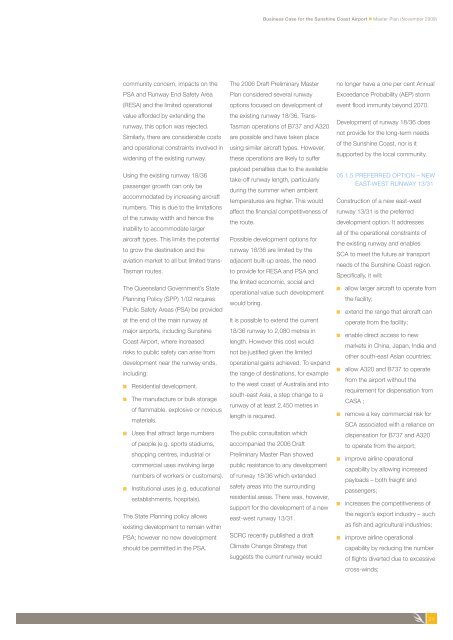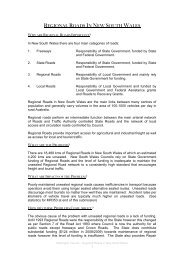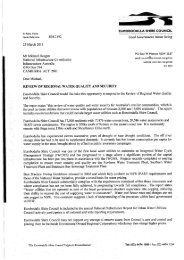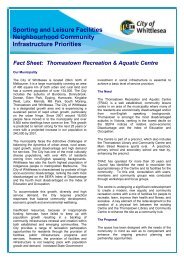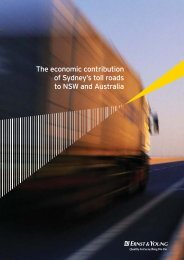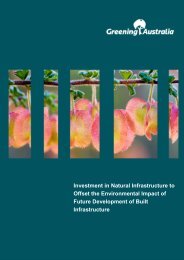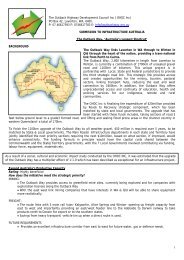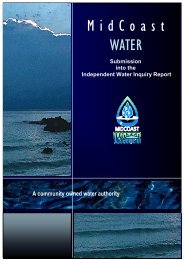Business Case for the SunShine CoaSt airport Master Plan
Business Case for the SunShine CoaSt airport Master Plan
Business Case for the SunShine CoaSt airport Master Plan
Create successful ePaper yourself
Turn your PDF publications into a flip-book with our unique Google optimized e-Paper software.
<strong>Business</strong> <strong>Case</strong> <strong>for</strong> <strong>the</strong> Sunshine Coast Airport n <strong>Master</strong> <strong>Plan</strong> (November 2009)<br />
community concern, impacts on <strong>the</strong><br />
PSA and Runway End Safety Area<br />
(RESA) and <strong>the</strong> limited operational<br />
value af<strong>for</strong>ded by extending <strong>the</strong><br />
runway, this option was rejected.<br />
Similarly, <strong>the</strong>re are considerable costs<br />
and operational constraints involved in<br />
widening of <strong>the</strong> existing runway.<br />
Using <strong>the</strong> existing runway 18/36<br />
passenger growth can only be<br />
accommodated by increasing aircraft<br />
numbers. This is due to <strong>the</strong> limitations<br />
of <strong>the</strong> runway width and hence <strong>the</strong><br />
inability to accommodate larger<br />
aircraft types. This limits <strong>the</strong> potential<br />
to grow <strong>the</strong> destination and <strong>the</strong><br />
aviation market to all but limited trans-<br />
Tasman routes.<br />
The Queensland Government’s State<br />
<strong>Plan</strong>ning Policy (SPP) 1/02 requires<br />
Public Safety Areas (PSA) be provided<br />
at <strong>the</strong> end of <strong>the</strong> main runway at<br />
major <strong>airport</strong>s, including Sunshine<br />
Coast Airport, where increased<br />
risks to public safety can arise from<br />
development near <strong>the</strong> runway ends,<br />
including:<br />
■■<br />
Residential development.<br />
■■<br />
The manufacture or bulk storage<br />
of flammable, explosive or noxious<br />
materials.<br />
■■<br />
Uses that attract large numbers<br />
of people (e.g. sports stadiums,<br />
shopping centres, industrial or<br />
commercial uses involving large<br />
numbers of workers or customers).<br />
■■<br />
Institutional uses (e.g. educational<br />
establishments, hospitals).<br />
The State <strong>Plan</strong>ning policy allows<br />
existing development to remain within<br />
PSA; however no new development<br />
should be permitted in <strong>the</strong> PSA.<br />
The 2006 Draft Preliminary <strong>Master</strong><br />
<strong>Plan</strong> considered several runway<br />
options focused on development of<br />
<strong>the</strong> existing runway 18/36. Trans-<br />
Tasman operations of B737 and A320<br />
are possible and have taken place<br />
using similar aircraft types. However,<br />
<strong>the</strong>se operations are likely to suffer<br />
payload penalties due to <strong>the</strong> available<br />
take-off runway length, particularly<br />
during <strong>the</strong> summer when ambient<br />
temperatures are higher. This would<br />
affect <strong>the</strong> financial competitiveness of<br />
<strong>the</strong> route.<br />
Possible development options <strong>for</strong><br />
runway 18/36 are limited by <strong>the</strong><br />
adjacent built-up areas, <strong>the</strong> need<br />
to provide <strong>for</strong> RESA and PSA and<br />
<strong>the</strong> limited economic, social and<br />
operational value such development<br />
would bring.<br />
It is possible to extend <strong>the</strong> current<br />
18/36 runway to 2,080 metres in<br />
length. However this cost would<br />
not be justified given <strong>the</strong> limited<br />
operational gains achieved. To expand<br />
<strong>the</strong> range of destinations, <strong>for</strong> example<br />
to <strong>the</strong> west coast of Australia and into<br />
south-east Asia, a step change to a<br />
runway of at least 2,450 metres in<br />
length is required.<br />
The public consultation which<br />
accompanied <strong>the</strong> 2006 Draft<br />
Preliminary <strong>Master</strong> <strong>Plan</strong> showed<br />
public resistance to any development<br />
of runway 18/36 which extended<br />
safety areas into <strong>the</strong> surrounding<br />
residential areas. There was, however,<br />
support <strong>for</strong> <strong>the</strong> development of a new<br />
east-west runway 13/31.<br />
SCRC recently published a draft<br />
Climate Change Strategy that<br />
suggests <strong>the</strong> current runway would<br />
no longer have a one per cent Annual<br />
Exceedance Probability (AEP) storm<br />
event flood immunity beyond 2070.<br />
Development of runway 18/36 does<br />
not provide <strong>for</strong> <strong>the</strong> long-term needs<br />
of <strong>the</strong> Sunshine Coast, nor is it<br />
supported by <strong>the</strong> local community.<br />
05.1.5 Preferred option – new<br />
east-west runway 13/31<br />
Construction of a new east-west<br />
runway 13/31 is <strong>the</strong> preferred<br />
development option. It addresses<br />
all of <strong>the</strong> operational constraints of<br />
<strong>the</strong> existing runway and enables<br />
SCA to meet <strong>the</strong> future air transport<br />
needs of <strong>the</strong> Sunshine Coast region.<br />
Specifically, it will:<br />
■■<br />
allow larger aircraft to operate from<br />
<strong>the</strong> facility;<br />
■■<br />
extend <strong>the</strong> range that aircraft can<br />
operate from <strong>the</strong> facility;<br />
■■<br />
enable direct access to new<br />
markets in China, Japan, India and<br />
o<strong>the</strong>r south-east Asian countries;<br />
■■<br />
allow A320 and B737 to operate<br />
from <strong>the</strong> <strong>airport</strong> without <strong>the</strong><br />
requirement <strong>for</strong> dispensation from<br />
CASA ;<br />
■■<br />
remove a key commercial risk <strong>for</strong><br />
SCA associated with a reliance on<br />
dispensation <strong>for</strong> B737 and A320<br />
to operate from <strong>the</strong> <strong>airport</strong>;<br />
■■<br />
improve airline operational<br />
capability by allowing increased<br />
payloads – both freight and<br />
passengers;<br />
■■<br />
increases <strong>the</strong> competitiveness of<br />
<strong>the</strong> region’s export industry – such<br />
as fish and agricultural industries;<br />
■■<br />
improve airline operational<br />
capability by reducing <strong>the</strong> number<br />
of flights diverted due to excessive<br />
cross-winds;<br />
21


